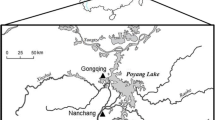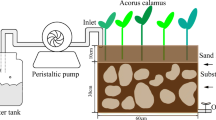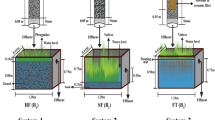Abstract
The choice of substrates with high adsorption capacity, yet readily available and economical is vital for sustainable pollutants removal in constructed wetlands (CWs). Two identical large-scale demonstration horizontal subsurface flow (HSSF) CWs (surface area, 340 m2; depth, 0.6 m; HLR, 0.2 m/day) with gravel or slag substrates were evaluated for their potential use in remediating polluted urban river water in the prevailing climate of northwest China. Batch experiments to elucidate phosphorus adsorption mechanisms indicated a higher adsorption capacity of slag (3.15 g/kg) than gravel (0.81 g/kg), whereby circa 20 % more total phosphorus (TP) removal was recorded in HSSF-slag than HSSF-gravel. TP removal occurred predominantly via CaO-slag dissolution followed by Ca phosphate precipitation. Moreover, average removals of chemical oxygen demand and biochemical oxygen demand were approximately 10 % higher in HSSF-slag than HSSF-gravel. Nevertheless, TP adsorption by slag seemed to get quickly saturated over the monitoring period, and the removal efficiency of the HSSF-slag approached that of the HSSF-gravel after 1-year continuous operation. In contrast, the two CWs achieved similar nitrogen removal during the 2-year monitoring period. Findings also indicated that gravel provided better support for the development of other wetland components such as biomass, whereby the biomass production and the amount of total nitrogen (TN; 43.1–59.0 g/m2) and TP (4.15–5.75 g/m2) assimilated by local Phragmites australis in HSSF-gravel were higher than that in HSSF-slag (41.2–52.0 g/m2 and 3.96–4.07 g/m2, respectively). Overall, comparable pollutant removal rates could be achieved in large-scale HSSF CWs with either gravel or slag as substrate and provide a possible solution for polluted urban river remediation in northern China.




Similar content being viewed by others

References
Abou-Elela SI, Golinielli G, Abou-Taleb EM, Hellal MS (2013) Municipal wastewater treatment in horizontal and vertical flows constructed wetlands. Ecol Eng 61:460–468
Arroyo P, Ansola G, Miera LES (2013) Effects of substrate, vegetation and flow on arsenic and zinc removal efficiency and microbial diversity in constructed wetlands. Ecol Eng 51:95–103
Ávila C, Garfí M, García J (2013) Three-stage hybrid constructed wetland system for wastewater treatment and reuse in warm climate regions. Ecol Eng 61:43–49
Babatunde AO, Zhao YQ, O’Neill M, O’Sullivan B (2008) Constructed wetlands for environmental pollution control: a review of developments, research and practice in Ireland. Environ Int 34:116–126
Bao SD (2000) Soil and agricultural chemistry analysis. China Agriculture Press, Beijing (in Chinese)
Barca C, Meyer D, Liira M, Drissen P, Comeau Y, Andrès Y, Chazarenc F (2014) Steel slag filters to upgrade phosphorus removal in small wastewater treatment plants: removal mechanisms and performance. Ecol Eng 68:214–222
Białowiec A, Davies L, Albuquerque A, Randerson PF (2012) The influence of plants on nitrogen removal from landfill leachate in discontinuous batch shallow constructed wetland with recirculating subsurface horizontal flow. Ecol Eng 40:44–52
Calheiros CS, Rangel AO, Castro PM (2008) Evaluation of different substrates to support the growth of Typha latifolia in constructed wetlands treating tannery wastewater over long-term operation. Bioresour Technol 99:6866–6877
Caselles-Osorio A, Garcia J (2007) Effect of physico-chemical pretreatment on the removal efficiency of horizontal subsurface-flow constructed wetlands. Environ Pollut 146:55–63
Chan SY, Tsang YF, Chua H, Sin SN, Cui LH (2008a) Performance study of vegetated sequencing batch coal slag bed treating domestic wastewater in suburban area. Bioresour Technol 99:3774–3781
Chan SY, Tsang YF, Cui LH, Chua H (2008b) Domestic wastewater treatment using batch-fed constructed wetland and predictive model development for NH3-N removal. Process Biochem 43:297–305
Comino E, Riggio V, Rosso M (2011) Mountain cheese factory wastewater treatment with the use of a hybrid constructed wetland. Ecol Eng 37:1673–1680
Cookson WR, Cornforth IS, Rowarth JS (2002) Winter soil temperature (2–15 °C) effects on nitrogen transformations in clover green manure amended or unamended soils; a laboratory and field study. Soil Biol Biochem 34:1401–1415
Dunne EJ, Culleton N, O’Donovan G, Harrington R, Daly K (2005) Phosphorus retention and sorption by constructed wetland soils in Southeast Ireland. Water Res 39:4355–4362
Faulwetter JL, Gagnon V, Sundberg C, Chazarenc F, Burr MD, Brisson J, Camper AK, Stein OR (2009) Microbial processes influencing performance of treatment wetlands: a review. Ecol Eng 35:987–1004
Gottschall N, Boutin C, Crolla A, Kinsley C, Champagne P (2007) The role of plants in the removal of nutrients at a constructed wetland treating agricultural (dairy) wastewater, Ontario, Canada. Ecol Eng 29:154–163
Huang L, Gao X, Guo J, Ma X, Liu M (2011) Study on the purification efficiency of micro-polluted river treated by subsurface horizontal flow constructed wetlands. Procedia Environ Sci 10:908–913
Jin Y, Wang X, Lu J, Zhang C, Duan Q (2008) Effects of modern and ancient human activities on mercury in the environment in Xi’an area, Shannxi Province, P.R. China. Environ Pollut 153:342–350
Johansson L, Gustafsson JP (2000) Phosphate removal using blast furnnice slag and opokamechanisms. Wat Res 34:259–265
Korkusuz EA, Beklioğlu M, Demirer GN (2005) Comparison of the treatment performances of blast furnace slag-based and gravel-based vertical flow wetlands operated identically for domestic wastewater treatment in Turkey. Ecol Eng 24:185–198
Korkusuz EA, Beklioglu M, Demirer GN (2007) Use of blast furnace granulated slag as a substrate in vertical flow reed beds: field application. Bioresour Technol 98:2089–2101
Lee MS, Drizo A, Rizzo DM, Druschel G, Hayden N, Twohig E (2010) Evaluating the efficiency and temporal variation of pilot-scale constructed wetlands and steel slag phosphorus removing filters for treating dairy wastewater. Water Res 44:4077–4086
Leto C, Tuttolomondo T, La Bella S, Leone R, Licata M (2013) Effects of plant species in a horizontal subsurface flow constructed wetland—phytoremediation of treated urban wastewater with Cyperus alternifolius L. and Typha latifolia L. in the West of Sicily (Italy). Ecol Eng 61:282–291
Li H, Li Y, Gong Z, Li X (2013) Performance study of vertical flow constructed wetlands for phosphorus removal with water quenched slag as a substrate. Ecol Eng 53:39–45
Liang MQ, Zhang CF, Peng CL, Lai ZL, Chen DF, Chen ZH (2011) Plant growth, community structure, and nutrient removal in monoculture and mixed constructed wetlands. Ecol Eng 37:309–316
MEP (2012) Bulletin of environmental state in China, 2012. Ministry of Environmental Protection, PRC, Beijing (In Chinese)
Name T, Sheridan C (2014) Remediation of acid mine drainage using metallurgical slags. Miner Eng 64:15–22
PLatzer C (1996) Enhance nitrogen elimination in subsurface flow artificial wetlands-a multi stage concept. In: Proceedings of the Fifth International Conference on Wetland systems for Water Pollution control, Vienna, Austria, September 15–19: I1/7-1-I/7-9
Roscher C, Scherer-Lorenzen M, Schumacher J, Temperton VM, Buchmann N, Schulze ED (2011) Plant resource-use characteristics as predictors for species contribution to community biomass in experimental grasslands. Perspect Plant Ecol Evol Syst 13:1–13
Sakadevan K, Bavor HJ (1998) Phosphate adsorption charateristics of soils, slags and zeolite to be used as substrates in constructed wetland systems. Water Res 32:393–399
Stefanakis AI, Akratos CS, Gikas GD, Tsihrintzis VA (2009) Effluent quality improvement of two pilot-scale, horizontal subsurface flow constructed wetlands using natural zeolite (clinoptilolite). Micropor Mesopor Mat 124:131–143
Stein OR, Hook PB (2005) Temperature, plants and oxygen: how does season affect constructed wetland performance? J Environ Sci Health A 40:1331–1342
Sundberg C, Stendahl JSK, Tonderski K, Lindgren PE (2007) Overland flow systems for treatment of landfill leachates—potential nitrification and structure of the ammonia-oxidising bacterial community during a growing season. Soil Biol Biochem 39:127–138
Sundblad K, Wittgren HB (1991) Wastewater nutrient removal and recovery in an infiltration wetland. In: Etnier C, Guterstam B (eds) Ecological engineering for wastewater treatment. Bokskogen, Göteborg, Sweden, pp 190–198
Truu M, Juhanson J, Truu J (2009) Microbial biomass, activity and community composition in constructed wetlands. Sci Total Environ 407:3958–3971
Valsami-Jones E (2001) Mineralogical controls on phosphorus recovery fromwastewaters. Mineral Mag 65(5):611–620
Vohla C, Põldvere E, Noorvee A, Kuusemets V, Mander Ü (2005) Alternative filter media for phosphorus removal in a horizontal subsurface flow constructed wetland. J Environ Sci Health A 40:1251–1264
Vohla C, Kõiv M, Bavor HJ, Chazarenc F, Mander Ü (2011) Filter materials for phosphorus removal from wastewater in treatment wetlands—a review. Ecol Eng 37:70–89
Vymazal J, Kropfelova L (2009) Removal of organics in constructed wetlands with horizontal sub-surface flow: a review of the field experience. Sci Total Environ 407:3911–3922
Wang Z, Dong J, Liu L, Zhu G, Liu C (2013) Screening of phosphate-removing substrates for use in constructed wetlands treating swine wastewater. Ecol Eng 54:57–65
Wang Q, Xie H, Zhang J, Liang S, Ngo HH, Guo W, Liu C, Zhao C, Li H (2014) Effect of plant harvesting on the performance of constructed wetlands during winter: radial oxygen loss and microbial characteristics. Environ Sci Pollut Res. doi:10.1007/s11356-014-3966-5
Waston JT, Reed SC, Kadlec RH, Knight RL, Whitehouse AE (1989) Performance expactations and loading rates for constructed wetlands. In: Hammer, D.A. (Ed.), Constructed Wetlands for Wastewater Treatment, Michigan
Xu D, Xu J, Wu J, Muhammad A (2006) Studies on the phosphorus sorption capacity of substrates used in constructed wetland systems. Chemosphere 63:344–352
Zhang D, Gersberg RM, Keat TS (2009a) Constructed wetlands in China. Ecol Eng 35:1367–1378
Zhang H, Qu J, Liu H, Zhao X (2009b) Characterization of isolated fractions of dissolved organic matter from sewage treatment plant and the related disinfection by-products formation potential. J Hazard Mater 164:1433–1438
Zhang T, Xu D, He F, Zhang Y, Wu Z (2012) Application of constructed wetland for water pollution control in China during 1990–2010. Ecol Eng 47:189–197
Zhao GY (2007) Screening and adsortption mechanisms on substrates for phosphorus removal in constructed wetlans. PhD thesis, Tongji University, China (in Chinese)
Funding
This research was funded by the National Program of Water Pollution Control (grant no. 2013ZX07310-001), Social development key project of Shaanxi Province (grant no. 2011KTZB03-03-03), and the Program for Innovative Research Team in Shaanxi (grant no. IRT 2013KCT-13).
Conflict of Interest
The authors declare that they have no conflict of interest.
Author information
Authors and Affiliations
Corresponding author
Additional information
Responsible editor: Philippe Garrigues
Rights and permissions
About this article
Cite this article
Ge, Y., Wang, X., Zheng, Y. et al. Functions of slags and gravels as substrates in large-scale demonstration constructed wetland systems for polluted river water treatment. Environ Sci Pollut Res 22, 12982–12991 (2015). https://doi.org/10.1007/s11356-015-4573-9
Received:
Accepted:
Published:
Issue Date:
DOI: https://doi.org/10.1007/s11356-015-4573-9



